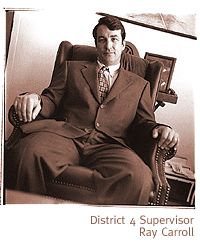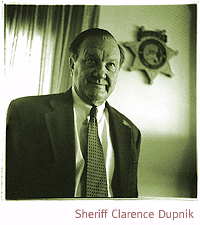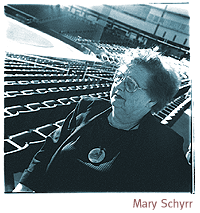
Pima County Taxpayers Will Soon Feel The Pain Of Recent Out-Of-Control Spending.
By Chris Limberis
PUSH HAS COME to shove in Pima County's deficit-producing $747
million budget. All the jousts are coming from combatants in the
diffusely operated county government--26 independently elected
officials. The sport of it can be captivating, distracting, amusing,
and maddening. The losers are certain:
Taxpayers.
 They'll get the bad news on Tuesday, February 9, when the Board
of Supervisors hears what possible spending reductions can be
wrung out at a time when demand for service, with steady population
increases, escalates.
They'll get the bad news on Tuesday, February 9, when the Board
of Supervisors hears what possible spending reductions can be
wrung out at a time when demand for service, with steady population
increases, escalates.
Lurking are tax increases. The options are not pretty. One tax
hike would add to what already is the highest county property
tax rate in Arizona. The other would impose the county's first,
and obviously reviled, half-cent sales tax.
"It's scary and it's stupid," said Mary Schuh, president
of the Pima Association of Taxpayers and a grandmother who spends
nearly every Tuesday morning babysitting the Board of Supervisors.
"For $747 million, this is embarrassing."
News of the shortfall, between $2.6 million to $6 million, broke
in December with the placid tone that comes only from years of
dire mid-year projections of deficits that are easily erased.
It's become such a common occurrence that it's seen by the few
civilians who pay attention almost as a ruse to make bureaucrats
or politicians look good.
 Raul Grijalva, a Democrat in his third term on the Board of Supervisors
from westside and UA-area District 5, affixed exactly that tone
of insouciance to County Administrator Chuck Huckelberry's deficit
news in December. Such projections, Grijalva announced, were an
annual ritual.
Raul Grijalva, a Democrat in his third term on the Board of Supervisors
from westside and UA-area District 5, affixed exactly that tone
of insouciance to County Administrator Chuck Huckelberry's deficit
news in December. Such projections, Grijalva announced, were an
annual ritual.
It's an attitude reinforced by the growth--economic, not just
sticks and stucco--propelling Tucson and metropolitan Pima County,
as well as by the county's own bravado with voter-approved authority
for record bond debt, and by the ambitious, expensive open-space
acquisition plan that has the daily media constantly salivating.
Indeed, the deficits bedeviling administrators of Pima County's
$164.7 million justice and law enforcement system are foreign
to the public works departments. Wastewater Management has a $55
million reserve and Development Services, with money from builders'
fees, has a surplus of nearly $6 million. In the cyclical county
budget that follows cyclical property and development markets
the Development Services account was once in serious deficit,
and in need of loans from the county general fund. But that general
fund was never fully repaid. In 1993, when the county was run
by the Republican majority of Ed Moore, Mike Boyd and Paul Marsh,
then-County Administrator Manoj Vyas wrote off about $1.5 million
in Development Service debt.
That write-off came during the same time that Boyd, Moore and
Marsh spent $20 million in reserves left by the previous administration.
With the clock ticking at five months left in the 1998-'99 fiscal
year, somehow, Huckelberry's warning seems more realistic and
much more troubling. And perhaps most alarming, and unrecognized
by the daily press, is the fact that the county has embarked on
a quiet scheme of borrowing--a scheme that voters know little
about and in which they had no say.
The numbers are staggering. The Pima Health Care System, a sprawling
department for indigent care, with its struggling HMO and the
22-year-old Kino Community Hospital, owes $35.8 million to the
Investment Trust Fund, interest-bearing accounts that combine
monies from the county and other political subdivisions including
school districts. Kino Hospital owes the fund $25.9 million.
"It's a big problem," Huckelberry acknowledged. "No
plan exists to repay this cash within the foreseeable future."
Officials from the state Auditor General's Office are expected
to reprimand the county for the borrowing.
Topping the roster of operating deficits:
 • The Sheriff's Department that operates on a $63 million
budget this year but is understaffed by as many as 240 deputies.
Current spending will leave Sheriff Clarence Dupnik, a popular
Democrat in office for 19 years, nearly $2 million in the hole.
• The Sheriff's Department that operates on a $63 million
budget this year but is understaffed by as many as 240 deputies.
Current spending will leave Sheriff Clarence Dupnik, a popular
Democrat in office for 19 years, nearly $2 million in the hole.
• Clerk of the Superior Court, a relatively obscure office
that until Republican Patti Noland took over last month was run
for 20 years by Democrat Jim Corbett. This deficit is expected
to be more than $1 million. A former one-term Tucson mayor, Corbett
loomed large in budget battles. Alternately eloquent and cantankerous,
Corbett simply took no guff from the supervisors he faced in annual
budget hearings. He consistently underspent and returned money
to the county general fund until thisyear, when he left Noland
with a deficit. His battle in 1984-'85 had echoes this year. Corbett
sued the supervisors that year and emerged with a victory--much
like one earned earlier by a Superior Court judge in Cochise County--which
established that while supervisors hold the purse strings, they
must provide elected department heads with sufficient resources
to perform their jobs.
• Lawyers contracted by the county to represent indigent
defendants have cost $1.3 million more than expected.
• The overburdened Juvenile Court Center is more than $564,000
over budget. The detention facility, designed for 86 detainees,
constantly has more than 120. Despite a 15-year-old federal court
order against such overcrowding, the first phase of voter-approved
expansion will be delayed about five months. Huckelberry is recommending
the delay to bring the center's budget in line. Such a move with
voter-approved projects is not unprecedented. When the Main Library,
over its $15 million budget by more than $5 million, was completed
in 1990, the city delayed its opening for several months because
of the lack of operating and maintenance funds.
Huckelberry, whose career with Pima County began in 1974, also
has ordered hiring freezes as well as freezes or sharp reductions
in equipment purchases. It has had some effect. Facilities Management
and the Public Fiduciary are back in the black.
The problem remains the massive projects voters approved in the
record bond issue of May 1997. The new parks and buildings cost
money to open, operate and maintain.
The tab next year for the Juvenile Center will be $8 million,
Huckelberry said. The center is being expanded in phases and it's
what the public evidently wanted. After rejecting a quarter-cent
sales tax for jails and juvenile facilities in 1994, county voters
overwhelmingly supported the Juvenile Center bond in 1997.
Voters approved overall Juvenile Center expansion to 220 beds.
"We're anxious to make use of it," said John F. Kelly,
presiding judge of Juvenile Court.
 Currently, the number of detainees is "artificially low,"
because of the lack of room, Kelly said.
Currently, the number of detainees is "artificially low,"
because of the lack of room, Kelly said.
Huckelberry has been busy watching the effects of county spending
and juvenile crime. The supervisors in 1993 began expanded and
direct appropriations for programs aimed at cutting juvenile crime.
What began with less than $500,000 jumped to $5 million a year
in the last few years. And while juvenile crime dropped slightly
last year, it had exploded from 1992 to 1996--tenfold according
to county statistics.
SHERIFF DUPNIK has--without panicky tone or any of the
cheesy gimmicks deployed by his colleague to the north, Maricopa
County's Joe Arpaio--asked for more money for years. His ratio
of deputies to citizens, at about 1.3 to 1,000, is far short of
the recommended national average, and it would take 240 new hires
to get him to that level.
Told to make cuts, Dupnik responded last week by announcing he
would cut the D.A.R.E. (Drug Abuse Resistance Education) program
that his officers present to 21,000 students at area schools.
That move would save $234,000, and the 10 officers who teach in
elementary and middle schools will be transferred to courthouse
security or patrol. That will allow him to move the corrections
officers now assigned to court security back to the jail.
Dupnik also reassigned two deputies from the retirement hamlet
of Green Valley to urban patrol, as he did with two from rural
Avra Valley. Finally, Dupnik shortened by two weeks the class
for a new batch of corrections officers.
Though non-confrontational by nature, Dupnik's relationship with
the supervisors has taken a strained tone--with the exception
of Boyd, a second-term Republican from central and foothills District
1. Boyd has consistently voted to support Dupnik, a sometime golfing
buddy.
Democrat Dan Eckstrom, the longest-serving member of the board
and one who has had a hot-cold relationship with Dupnik, was unimpressed,
barking: "I didn't tell the Sheriff to overspend."
Two of Dupnik's moves clearly were aimed at Supervisor Ray Carroll,
the Republican who represents Green Valley and eastside District
4. Dupnik supported Carroll in his three-way primary against Brenda
Even and Ken Marcus in September.
Two months later, Carroll was the lone holdout on a proposed half-cent
sales tax, which could raise about $45 million a year. A unanimous
vote was needed, and Carroll's dissent killed the chance for a
revenue stream that Dupnik, Huckelberry and the four other supervisors
wanted.
 Carroll really had nowhere to go. He campaigned against the sales
tax. A logical move in District 4, or really anywhere in Pima
County given that three sales tax proposals have failed by increasing
margins in 1986, 1990 and 1994. And his vote was made easier by
the arts-culture group that lined up at the trough on the day
of the vote, wanting to take half the revenues away from Dupnik.
Carroll really had nowhere to go. He campaigned against the sales
tax. A logical move in District 4, or really anywhere in Pima
County given that three sales tax proposals have failed by increasing
margins in 1986, 1990 and 1994. And his vote was made easier by
the arts-culture group that lined up at the trough on the day
of the vote, wanting to take half the revenues away from Dupnik.
But tax backers and the Sheriff's supporters insist Carroll had
told them he would relent. Carroll and his staff say that's flatly
untrue. And Carroll points out that he's supported Dupnik on his
other requests.
The battle, though muted and generally polite on the surface,
is nonetheless simmering. Carroll was offended when Dupnik showed
up at the board's Canoa Ranch rezoning and spoke in favor of the
development, which crashed on a 4-1 vote, with only Boyd opposed
to Carroll's motion to kill it.
Carroll cracked the next week that if the Sheriff could tell
the board about land planning, then he could recommend cuts.
Players, inside the county and out, have been asking in the last
week where Dupnik is getting his advice, particularly in light
of the shakeup at his headquarters that included the retirement
of highly respected Major David Bosman.
And despite the surface popularity of D.A.R.E., officials, including
those in the Sheriff's Office, concede there's no data to prove
the program's effectiveness.
"I have the deepest respect for the Sheriff, but I have
to think he's getting some very bad advice," said the county
watchdog Mary Schuh. "The timing and the choice of his cuts,
the elderly in Green Valley and the kids--that bothers people
a lot."
THE CURRENT deficits could get worse, with added financial
problems for a favorite budget target of Schuh and her husband,
Jim. Revenues at the county's major league spring-training complex,
which cost $36 million to build, are not close to meeting operating
expenses and debt payments.
The complex, with its Tucson Electric Park stadium, is the spring-training
home of the Arizona Diamondbacks and Chicago White Sox. It's also
home to the Tucson Sidewinders, the AAA team of wealthy speculator
Martin Stone.
 Baseball promoters, led by former major league pitcher Dan Schneider,
an insurance salesman, and Mike Feder, the Sidewinder's general
manager, repeatedly promised taxpayers, and city and county officials,
that the facility would pay for itself with revenues from teams
and tax revenues from fans. Schuh and others remember how anyone
who raised questions about Schneider's grossly inflated figures
was branded anti-baseball.
Baseball promoters, led by former major league pitcher Dan Schneider,
an insurance salesman, and Mike Feder, the Sidewinder's general
manager, repeatedly promised taxpayers, and city and county officials,
that the facility would pay for itself with revenues from teams
and tax revenues from fans. Schuh and others remember how anyone
who raised questions about Schneider's grossly inflated figures
was branded anti-baseball.
But the complex is costing the county $4.5 million a year, $3.5
million in bond payments and $1 million in operation and maintenance.
Revenues were $300,000 short last year.
The county has used a tax on car rentals to pay for the new stadium,
as well as for the completed renovations to the city's Hi Corbett
Field, where the Colorado Rockies train. The car-rental tax, approved
by the supervisors in 1991 at $2.50 per rental, is now $3.50.
That brings in about $1.6 million a year, while a bed tax approved
by supervisors three years ago brings in $1.3 million a year.
The last piece of tourist taxes for baseball--a 50-cent-a-night
surcharge on RV spaces--has been the most controversial and is
on the chopping block.
The RV tax has brought in $200,000, far less than the $800,000
anticipated. Still, the elimination of the RV tax, now expected
to bring in $300,000, would mean property owners would have to
cough up the difference--about 1 cent on the county's property
tax rate of $5.24 per $100 of assessed value. Translation: an
increase in what is the state's highest property tax rate and
an extra $1 a year for the owner of a $100,000 home.
Supervisors levied the tax in 1997 and did not anticipate the
anger it would cause. It's clearly the most confusing, poorly
administered and difficult tax. RVers with lots of time on their
hands have joined forces with park owners to battle the tax. Communication
is swift and furious. And the RVers' anger ignores the rate increases
park owners have levied. They've engaged irrepressible lobbyist
and former state lawmaker Scott Alexander, who earlier attempted,
but failed, to land a contract to lobby state government on behalf
of the county.
The champion of the repeal, state Rep. Bill McGibbon, a Green
Valley-area Republican, also was the baseball and spring-training
champion. He was not in office when the state, in a package to
preserve the Cactus League, gave Pima County authority to levy
the RV tax, the car rental tax and permission to ask voters to
approve a 1/10th of a cent sales tax for spring training facilities.
But McGibbon was the leader for the baseball boys when the county
needed permission to increase the car rental tax from its previous
$2.50 cap and to give the county the ability to double to hotel
bed tax to one percent.
Now he says the RV tax unfairly targeted a single industry and
single group. He has allies in Tucson, including Democrats from
District 11, Sen. Elaine Richardson and Rep. Carmine Cardamone.
The district, like that of McGibbon's District 9, includes a number
of big RV resorts as well as smaller parks.
"This whole baseball thing is out of control," Mary
Schuh said. "They misled the people. They claimed they were
the experts and they said it wasn't going to cost us anything.
It's unconscionable and irresponsible."
HOW THE COUNTY digs out of this financial mess is unclear.
And it's not likely that supervisors will provide Huckelberry
with any detail on February 9.
Schuh and her group have not always agreed with Huckelberry,
an unassuming and pleasant engineer who grew up in Flowing Wells
and who seemed destined to run county government. Schuh even has
sympathy for the county's top bureaucrat as he tries to stabilize
the county's finances.
"It's gotten worse," Schuh said of the board. "They
don't seem to learn from their past mistakes. And he's dealing
with a hydra."

|





